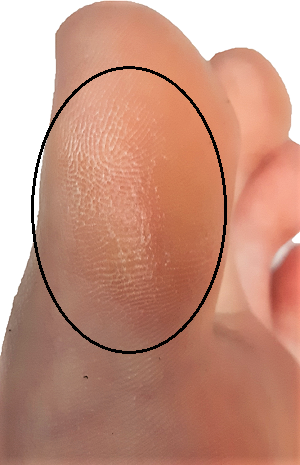
What do your calluses mean?
Calluses on your feet develop when there is more pressure on a particular spot. Why does that spot develop pressure? What do these calluses mean? There are multiple reasons why your feet might develop a callus, such as shoe fit and the way your is moving. Before going into the details about why the callus has developed, it is important to know where the callus is. That will determine what may be causing your callus. The more common areas to develop a callus are the side of the big toe, the ball of the foot, the little (pinky) toe, the arch and the heel.
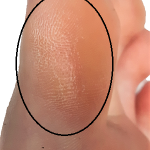
Big toe callus
A callus on the big toe typically forms on the inside. Those with a flat foot or collapsed arch may develop this callus. When the arch is low/collapsed, the foot usually rolls in while pushing off the back leg. This puts all the pressure on the inside of the big toe, leading to a callus.
Certain sports, exercise routines or other activities may form or exaggerate this callus due to the action performed. For example, tennis is a sport with a lot of side to side movements. These movements create more pressure at the inside of the toe, which is not related to abnormal walking patterns.
Shoe fit may not be the main cause of the callus, but it can contribute. When wearing a shoe with a very pointed toe, this will create more pressure on the sides of the toes. This extra pressure on the side of the big toe can contribute to a callus formation.
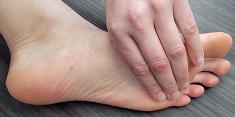 Ball of the foot callus
Ball of the foot callus
If a callus has formed under the ball of the foot (front of the foot), this is likely due to a metatarsal arch collapse. A metatarsal arch is the arch across the ball of the foot. It should create a dome to provide less overall pressure. When the arch collapses, the ball of the foot will take on excessive pressure, creating a callus.
With a metatarsal arch collapse, it is important to be aware of your shoes. Tight fitting shoes won’t contribute to the callus, but they can contribute to pain, especially when combined with a collapsed metatarsal arch.
It is also important to be aware of your shoes breaking down. With more pressure at the ball of the foot, this area on the shoe sole will break down faster. Once this area begins to break down, the metatarsal arch collapse is exaggerated when wearing the shoe. If pain or callusing is worsening, note how old the shoes are and replace if necessary!
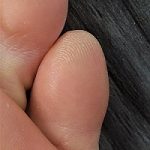 Pinky toe callus
Pinky toe callus
Occasionally, a callus in a line may form under the pinky toe (fifth toe). The lined callus is called a “pinch callus” because it forms when the skin is pinched consistently over a long period of time. This callus commonly forms due to shoe fit. If the shoe is either very pointy or too narrow, the pinky toe gets pinched between the shoe and the neighbouiring toe.
Another way this callus can form is due to the way you are walking. If you have a high arch and all your weight is on the outside of the foot when walking, this can cause the fourth toe to push against the pinky toe. A flat/collapsed arch can also create this callus in a shoe. If the arch collapses, the front of the foot can shift towards the outside of the shoe, pinching the pinky toe.
Arch callus
A callus can also develop under the arch of the foot, around a bone called the navicular. This bone will shift/stick out with a very flat foot or severe arch collapse. Because this bone becomes more prominent, there is more pressure. The pressure can develop from the contact of the bone on the ground, or rubbing on a shoe when the arch is collapsing with every step.
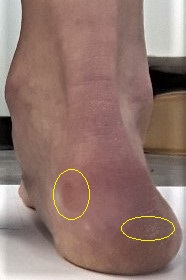 Heel callus
Heel callus
Callusing on the heel is another common area, which can develop at the very back of the heel (Haglund’s deformity) or around the border of the heel. If a flat/collapsed arch also causes the heel to collapse, the back of the heel rubs on the inside of the shoe, causing a callus or bumps called Haglund’s deformity.
Calluses around the border of the heel typically develops from a ridge rubbing on the back of the heel. This can be from an orthotic device, a harder insole or from the ridge of a sandal.
At times, heel callusing can be mistaken for dry skin or other skin conditions. One way to determine if that is the case, is to look for skin cracking or flaking. Use medicated creams to treat this.
Treatment
Knowing where your calluses are and why they are developing can help to prevent them from worsening, or even by reducing the pressure all together. Removing the pressure from the area through proper support and footwear is important. To actually remove the callus, a health care professional such as a Footcare Nurse, Chiropodist or Podiatrist can help to remove them.
If you have any further questions, or you need your feet looked at, feel free to contact us or book an appointment!

You must be logged in to post a comment.